First I’ll share tips on how to introduce a new puppy or adult dog to your cat, along with what to consider before you even bring Fido home in the first place.
I also cover the tough decision of having to re-home a dog who’s determined to harm your resident cat.
I’m Barbara and I write regularly for That Mutt. I’m also a blogger over at K9s Over Coffee.
Can dogs and cats really coexist peacefully?
Since dogs and cats aren’t necessarily known as BFFs, let’s first answer the question of whether or not they can really coexist peacefully. The quick answer is yes, they can under certain circumstances and depending on variables such as:
- Cat’s and dog’s age
- Personality
- Socialization history
- Dog’s breed and size
- The human’s patience
Examples of peaceful dog/cat coexistence
My friend Laura has a very gentle Golden Retriever, Lucy, and two cats, Domino and Scott. They’re not BFFs, but they respect and get along with each other.
One of my dog walking clients has a Labrador, an American Bulldog AND a cat. Same scenario here – they’re not best buddies, bet they get along and coexist peacefully.
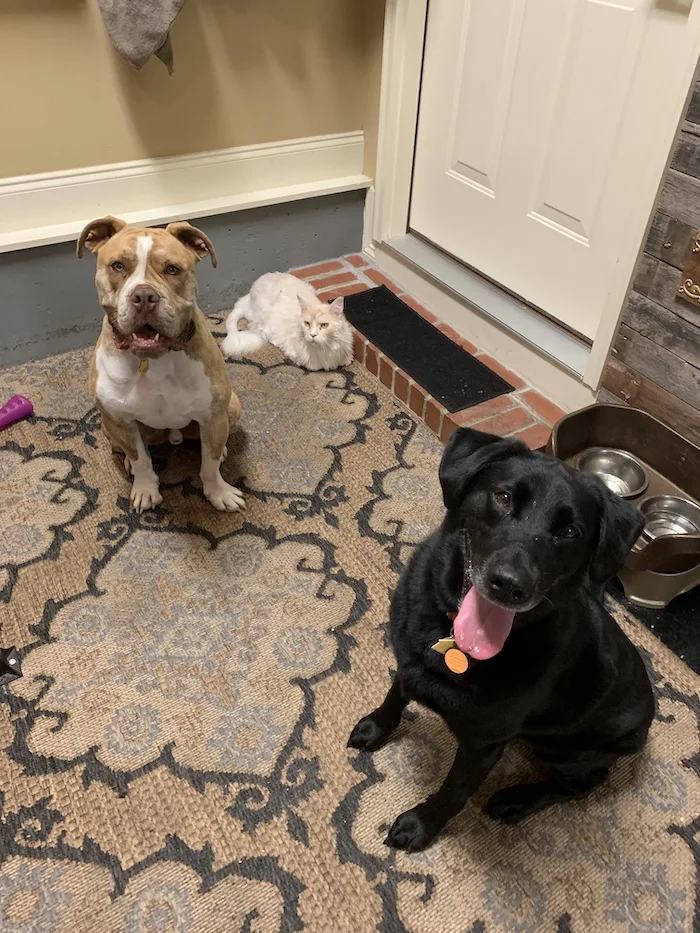
That’s ever since Sherman the cat put the Bulldog in his place with a well placed claw paw when the bulldog was a puppy and overly eager to chase Sherman.
Macy, the Labrador, is mellow and easygoing. Consequently, she never bothers the cat.
That Mutt‘s Lindsay also has a cat named Scout and a weimaraner named Remy who get along. They’re not “friends” by any means but they get along just fine. Lindsay leaves them loose together when she’s not home and she doesn’t worry about them at all.
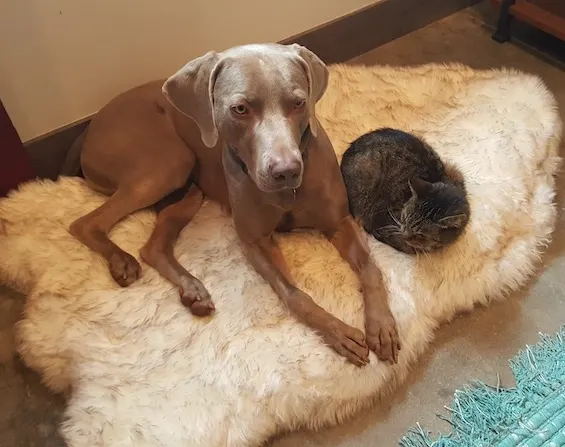
So yes, cats and dogs can live together under certain circumstances. That being said, the three homes I just mentioned have one common denominator.
They all had their cats first before they brought their dogs home as puppies.
Which dog breeds generally don’t get along well with cats?
Dog breeds who might not do well with cats are hunting breeds because of their strong prey drive. The same applies to herding breeds because they tend to be enthusiastic about herding the family, including the cat. Finally, certain terriers also have a strong prey drive.
Lindsay’s Weimaraner Remy is a hunting breed, so technically he’s not predisposed to living with a small animal that has a prey-like appearance like a cat.
However, since Remy joined Lindsay’s family as a puppy, he was properly socialized to Scout, the cat. He’s been doing just fine around him.
See That Mutt’s post: Can weimaraners live with cats?
On the other hand, Lindsay tried to add an adult Weimaraner named Raven to her family this year and had no luck with that endeavor.
Raven is actually Remy’s full sister but hadn’t been socialized to cats as a puppy. As a result, she was obsessed with trying to chase and kill Scout, which obviously was a dealbreaker.
More on that in the section “Is it ok to re-home the dog?” at the end of this article.
My own pup Wally is a Feist, which is also a hunting breed. A squirrel hunting breed to be specific. I adopted Wally when he was one year old, and he goes nuts whenever he sees a cat!
I’ve had to implement several techniques like changing directions when he sees a cat on a walk, impulse control, and taking him to a different room when he spots one through a window at home!
See my article How to Stop your Dog from Chasing Cats for my ideas.
So while I really like cats, there’s no way I’d be able to have a cat join us, nor would I have been able to adopt Wally if I already had a kitty!
But that’s OK. I know I can’t have a cat with Wally, and it’s not his fault. It’s simply in his genes to want to chase small animals like cats, and I have to respect that.
Which dog breeds tend to get along with cats?
Now that we have an understanding of which breeds might not do well with cats, let’s talk about breeds that are often fine with cats. Those are some sporting dogs, retrievers, and toy breeds such as:
- Cavalier King Charles Spaniel. Toy breed.
- Pug. Toy breed.
- Maltese. Toy breed.
- Pomeranian. Toy breed.
- Beagle. Low to the ground.
- Basset Hound. Low to the ground.
- Golden Retriever. Gentle and mellow.
- Collie. Gentle.
- Poodle. Gentle.
- Newfoundland. Although they’re giant in size, they’re known to be gentle giants with lower energy and who get along with other pets.
Of course there are going to be variations within each breed. For example, there may very well be a golden retriever who’s into chasing cats, just like there might be a German shepherd who’s best friends with a cat. However, generally speaking, the dogs I just listed above are often just fine with cats.
What to consider before you introduce a dog to your cat
You’ve probably guessed it by now, there are a few things to consider before you introduce a dog to your cat. I recommend you ask yourself the following questions:
1. Can I adopt a puppy as opposed to an adult dog? Puppies are more work than older dogs who are already house trained, but they’re likely the better option in this particular scenario because a puppy can more easily be socialized to your cat.
By the way, the easiest way to ensure that your cat and dog duo get along is to adopt or buy a kitten and a puppy at the same time!
2. What breed is the dog I plan on adopting? Adult hunting breeds and herding dogs aren’t the best option because of their prey drive and herding tendencies. That being said, you might be able to find an adult dog that has grown up with cats or has been in a foster home with cats and co-existed OK.
3. Does the dog have any behavioral issues? Ask the rescue staff for clues! For example, was the dog surrendered because he didn’t get along with a cat or other small pet? Have they seen him interact with cats during his time at the shelter/rescue facility?
Once you’ve made the decision to adopt a particular dog, it’s time to bring him home with you!
Also, communicate clearly with the rescue staff. Let them know that you’re looking for a dog who needs to get along with your resident cat.
They will probably be able to point you towards the right doggie candidates. Sometimes they will do “cat testing” right at the shelter where they safely observe the dog’s reaction to a cat or cats at the shelter. On the other hand, some shelters do not bother to “cat test” the dogs.
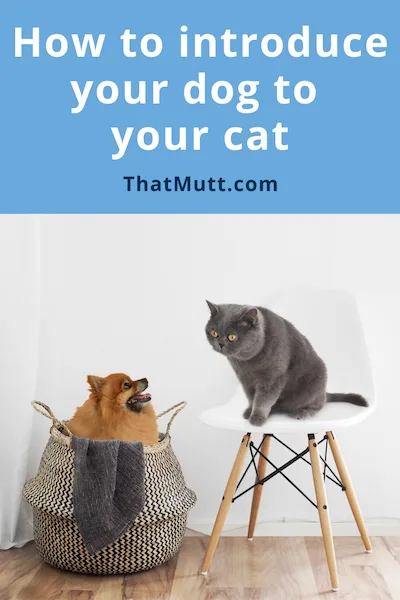
Bringing the new dog home
Although this is an exciting time, try to be as calm as possible when your new buddy steps into your home. The calmer you are, the calmer your pup will be.
Walk your dog
I also recommend taking your puppy or adult for a walk in your neighborhood before inviting them inside your home, especially if you were in the car for a longer time.
It’ll burn some mental energy by taking in all the new sights and smells, and obviously it will also allow them to get rid of some of their physical energy.
It’s exactly what I did with my Feist Wally when I brought him home from the foster family where he had been staying. We had been in the car for an hour, and he was ready to stretch his legs when I pulled into my driveway. So before even opening the garage, we went for a 45 minute walk around the neighborhood.
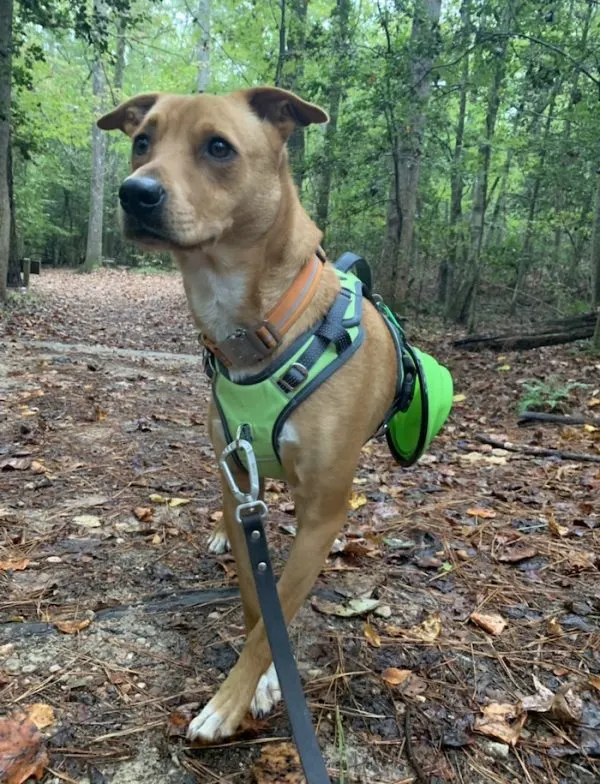
Short period of separation with scent introduction
Once you bring your pup inside, allow him a day or two to get situated before introducing him to your cat. This short period of separation is a good time for both the cat and the dog to familiarize each other with the new scent.
Make sure that your cat has his own space during this time, such as his own room. Let your pup and your cat hang out or snooze on their very own blankets, then give your dog the cat’s blanket and vice versa. When you exchange their blankets, they’ll be able to get a little indirect scent introduction.
Provide their own spaces
This might seem counterproductive at first sight since your ultimate goal is to have your cat and dog get along together. However, both will appreciate having their very own space where they feel safe and can get a break.
Your pup will do well with his own bed and/or crate if you decide to crate-train him. Your cat needs somewhere to hide like a scratching tree, floating shelves, and/or her very own cat room.
Or just any room or space in your home that’s off limits for the dog, equipped with a cat door the pup won’t fit through. This could be a home office, a guest bedroom, den, or the laundry room.
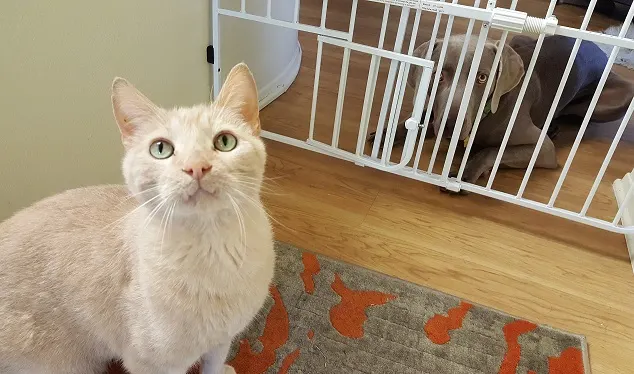
The different phases when you introduce a dog to your cat
The main ingredients for the introduction are patience and calmness on our part, the human. It’s also best not to force any interaction and to take the dog for a walk beforehand, much like you did before you brought him into your home. If the dog is still a puppy, the walk can be shorter than it should be for an adult pup.
Next up it’s important that you, the human, are there with the animals throughout all phases of the introduction. That way you’ll be able to control and redirect if necessary.
Phase 1: Safety first – closed door
Introduce your cat and your dog through a closed door first, ideally with an adult on each side who rewards positive behavior with treats and attention.
Phase 2: Enter the gate
Next, let them see each other, but still have them separated by a physical barrier, like a gate for example. The dog should still be on a leash because a large dog or even a smaller dog might hop right over the gate. Brave, curious kitties might also hop over the gate and unknowingly put themselves in danger.
Phase 3: Same room
If that goes well, try having them be in the same room together, with your dog leashed so you can quickly intervene if necessary. Also make sure that your cat has an escape route, just in case.
If it doesn’t go well, grab your dog’s leash and redirect your dog’s attention to something other than the cat, and try again at a later time. This could mean taking him for another walk or offering him a tasty dog food puzzle. It’s best not to play a game of fetch or tug with your dog before this phase to ensure that he’s not in a chasing mood.
You could consider having your dog wear a muzzle if you’re worried about your cat’s safety when you’re ready to try again.
Phase 4: Patience when you introduce a dog to your cat
It can take several weeks or even months for them to truly be comfortable around each other – cats tend to be more territorial than dogs. Also, make sure to give your cat AND your dog equal attention so they don’t have to compete for it!
This is where your patience and consistency are important. It will also pay off to train both your dog and your cat to be respectful of one another, as well as to listen to you.
Training your dog and your cat
It’s important to train both your cat AND your dog, although you’ll reap the most obvious benefit from training your dog. However, your cat also needs to understand that she has to behave politely around the dog and can’t just smack him whenever he walks by.
Teaching impulse control and obedience commands
Now, the ultimate goal for your dog is to behave politely around your cat because – let’s face it – a dog can do more damage to a cat than the other way around. What exactly does that entail? It means learning impulse control for times when they’re alone, and listening to your obedience commands when you’re around.
Those are commands like leave it, come, sit, stay, and possibly going to his place on command. They’ll all come in handy when you want to interrupt your dog’s behavior and redirect him to do something else. For instance, stop chasing the kitty and go lie down on your bed instead!
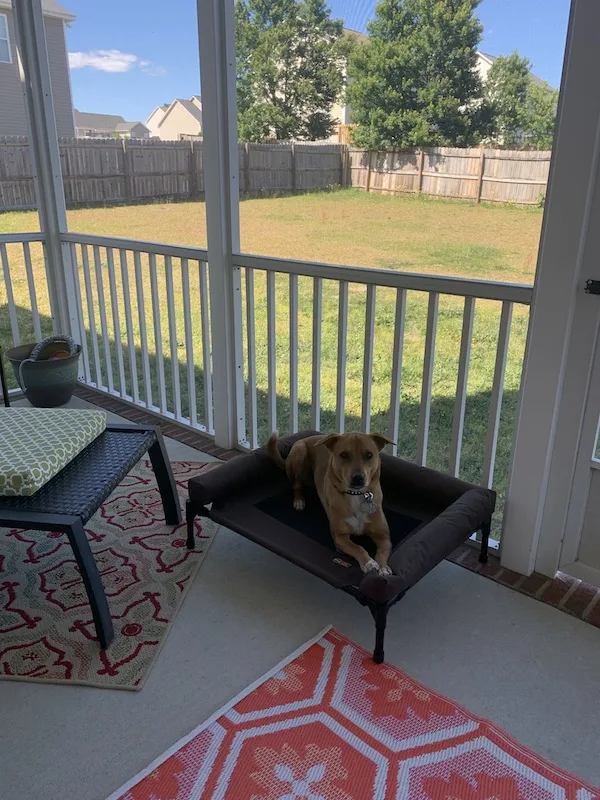
Or, sit politely next to your food bowl and wait for my ok to eat without bullying your kitty while she’s trying to eat her food.
Crate training when you introduce a dog to your cat
Until you’re confident that your dog and your cat get along peacefully at all times, even when you’re not around, it’s a good idea to keep them physically separated for at least the first 3 months or so.
For example, you could keep your cat in her cat room or area of the house that’s off-limits for your dog. You could also, or additionally, crate your dog when you can’t actively supervise your pets’ behavior.
You’ll need a crate that’s just the right size for your dog. It needs to be large enough for him to comfortably move around and stand in, but not too large where he’d be encouraged to go potty at one end of the crate.
If your dog is a growing puppy, it’s a good idea to invest into a larger crate that comes with a divider. That way, you won’t have to buy multiple crates until he’s fully grown.
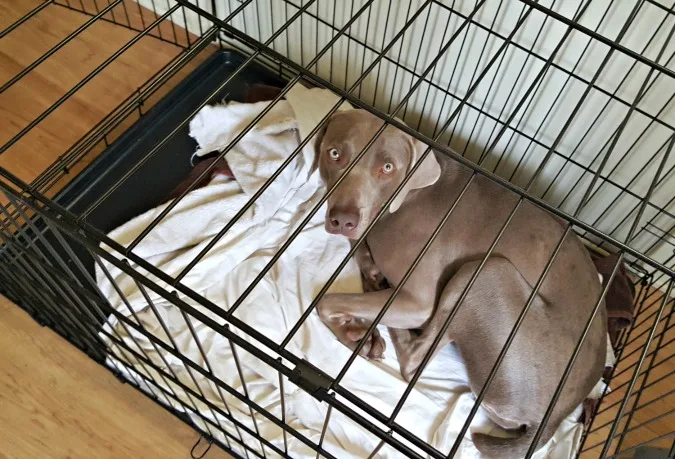
Leash training
If your new dog is a puppy, it’s also important to start leash-training him right away. That’s not only so you can take him on structured walks, but also because the leash can be an important tool in conditioning your pup to your kitty.
Consider it an extension of your arm when you’re holding it, and a means of allowing him more freedom when he’s just dragging the leash behind him.
For example, you can allow your dog some slack on the leash when he’s meeting your cat in the same room. That way, you can still redirect him when you’re holding the leash should he misbehave.
Once he consistently acts politely around your cat while you’re holding his leash, drop it and allow him to interact more freely with your cat. He’ll appreciate the increased freedom.
However, you’re still able to intervene and redirect should he be too rough or pushy with the kitty.
Addressing potential problems when you introduce a dog to your cat
If these interactions turn out to be consistently stressful for your cat because your dog is uber excited and maybe even aggressive, don’t hesitate to ask a dog trainer or animal behaviorist for help. You could ask your trusted vet for a recommendation or do an internet search.
Signs of dog aggression towards cats are:
- Staring
- Growling
- Snapping
- Stiff body posture
- Hackles up
- Breathing/panting heavy
- Teeth chattering
- Lunging
- Foaming at the mouth
- Dilated pupils
Tips to avoid ugly scenarios:
- Don’t free-feed your dog or your cat to avoid potential food related aggression. It’s best to have set feeding times, for example breakfast in the morning and dinner in the evening. Always supervise mealtime, and/or physically separate your dog and cat. Pick up their bowls when they’re done eating. That’s because even empty bowls can cause a fight over imaginary leftovers.
- Learn how to properly use a muzzle on your (larger) dog when he interacts with your cat and you’re not convinced he’ll behave himself. It probably won’t be necessary for a toy breed like a Cavalier King Charles Spaniel, but will be useful on a larger dog. See That Mutt’s article How to Get Your Dog Used to a Muzzle for more information on this topic.
However, it’s important to note that dogs aren’t always the bad guy.
Signs of cat hostility towards dogs are:
- Staring
- Hissing
- Growling
- Flat ears
- Tense body posture
- Lunging
Is it ok to re-home the dog?
If all your efforts fail and your cat and dog just can’t find any common ground, it’s time to think about a realistic solution such as rehoming the dog.
I already alluded to this topic briefly when I mentioned that Lindsay’s new Weimaraner ended up trying to kill Scout, her cat. Unfortunately, she was truly out to kill him, so Lindsay made the decision to find a cat-less home for Raven after all.
See That Mutt’s article When the Dog You Adopt Doesn’t Work Out for more in-depth information from Lindsay herself. She did consult with a professional trainer for another opinion.
The trainer suggested it would be best to re-home Raven because the cat would never be truly safe. Lindsay would’ve had to manage the two all the time, and one mistake would mean death for the cat.
I’d like to stress that neither Lindsay nor I are huge fans of rehoming dogs. However, sometimes the dog (or cat, for that matter!) you decided to bring home truly doesn’t work out. In that case, it’s wise to be realistic and understand that it’s not a good fit, and to find a different home for the pup.
This move can literally save lives and a lot of stress for all parties involved, including your cat, the dog, and yourself.
Now we’d like to hear from you!
How did you introduce a dog to your cat? Do you have any additional advice?
If you have any questions, let us know in the comments!
Barbara Rivers writes regularly for That Mutt. She is certified in raw dog food nutrition from Dogs Naturally Magazine and the author of three ebooks about balanced raw dog food. She is a blogger at K9s Over Coffee.

Ruta Frew
Tuesday 24th of May 2022
It’s not the dog it’s the cat that is the problem. She hisses, growls and is just a snoot. She was a feral kitten. The dog wants to play. He whines , cries, has his front feet down and rear up. Any ideas on how to deal with this situation?
Carol (Mattie's Mom)
Saturday 6th of June 2020
Previously, we dogsat for friends, so our Murray (feline) was used to lots of dogs. We adopted Murray when our Mandy was along in years. Next came Mika (husky mix) who was very respectful. And then came Mattie, a 6 month lab mix pup. We thought it would be safer to introduce a younger dog than an adult dog (the rescue organization had not tested her with cats). It has been a challenge! At this point Mattie continues to stir the pot by muzzle butting Murray if she needs someone to play with. Mattie seems to have no clue what hissing and growling mean. But Murray also likes the interaction, but it is just that Mattie can be overwhelming (thus she is often on leash in the house). One thing is that they both are treat motivated and we have treats together. Mattie has to sit while Murray retrieves his treat. At this point (nearly a year since we adopted Mattie), Mattie is crated when we are outside since we don't totally trust the two of them along (though Murray has a cat tree and a cat door to the basement to escape).
Aisling
Thursday 28th of May 2020
I don't have a cat and my border terrier will not let me either! However, I have serious issues with neighbourhood cats coming into my garden (sitting on my windowsills) and one cat has found a perfect tree to hunt in....in my back garden! My dog goes ballistic when she sees it and unfortunately, she can see out both gardens from nearly every room in the house. The cat aloof as ever doesn't move an inch when I try chase it away. As my dog has a heart condition, I try do everything to keep her calm when she sees one. Its so hard! As we are working from home these days, being able to control her is a little bit easier. She's 9 years old and ive just accepted that this is a battle I am always going to have to face!
Lindsay Stordahl
Thursday 28th of May 2020
Oh man, yes that sounds frustrating. I'd probably go out with a hose and spray the cat away or something!